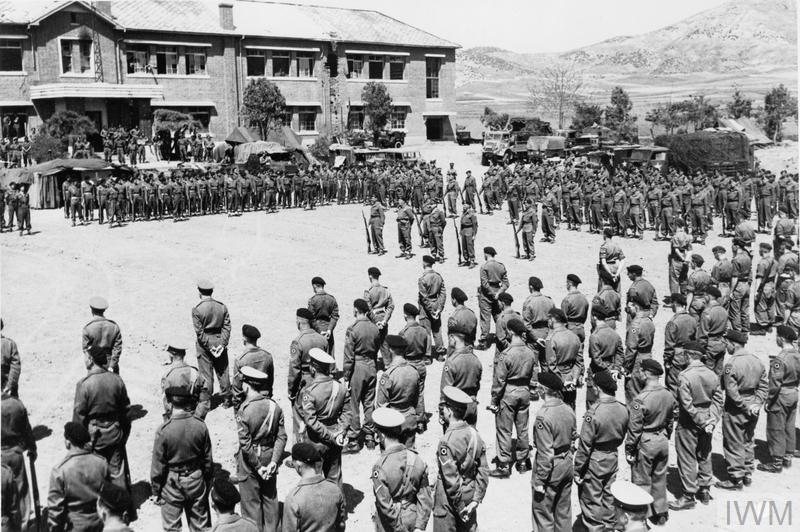IWM holds a collection of photographs which helps tell the story of the Korean War, which started on 25 June 1950 and lasted until 27 July 1953.
Often referred to as the 'Forgotten War', the conflict impacted considerably on the civilian population, with around 2.5 million people becoming casualties of the violence.
Korea was partitioned after the Second World War along the Korean Peninsula. The area north of a dividing line in the middle of the country, known as the 38th Parallel, fell under Soviet control, whilst the region to the south came under US influence. The 38th Parallel divided the Korean Peninsula in half and following growing tensions between opposing sides, a North Korean army crossed the 38th Parallel on 25 June 1950 and swiftly advanced south.
The United Nations sent an international force, led by the Americans, to fight with South Korea. After initial success, the UN forces retreated in the face of Chinese support for the north. The situation developed into a war of attrition until the Korean Armistice Agreement was signed on July 27 1953.
Substantial numbers of military personnel from 16 UN nations– including the US, Great Britain, New Zealand, Australia, South Africa and Canada – fought as part of the UN Force. It is unknown exactly how many people lost their lives during the conflict, the first military action of the Cold War.
This collection of 25 photographs shows the experiences of some of the many men who served in Korea and the conditions in which they lived and fought during the Korean War.
Off to war

British troops leave Hong Kong to join United Nations forces in South Korea, September 1950. Men of the 1st Battalion, Argyll and Sutherland Highlanders boarding the cruiser HMS Ceylon for the journey to Pusan, South Korea. In the background the band of the King's Own Scottish Borderers play on.
Arriving in Korea

Private Ron Pattison of the 1st Battalion, Durham Light Infantry, is greeted on his arrival in Korea by American Sergeant First Class Robert Tutt, September 1952.
Inchon advance

American Marines advancing through the outskirts of Inchon at 08.30 hours on 16 September 1950 at the start of the Battle of Inchon.
Happy Valley

Men of the 1st Battalion, The Royal Ulster Rifles dig trenches in 'Happy Valley', north of Seoul, just before the Chinese attack of 2 January 1951.
Crossing the Imjin

An American M46 tank leads British Centurion tanks across the Imjin River.
Night patrol

A British infantry patrol at night.
Making friends

A British soldier talks with Korean children.
Intensive bombardment

Stripped to the waist in a temperature of nearly 100 degrees Fahrenheit (37 degrees Celsius), men of a 3-inch mortar team of the 1st Battalion, The King's Own Scottish Borderers work overtime during an intensive bombardment of Chinese-held hills, 15 July 1952.
The Gunner

A British gunner serving in Korea reads 'The Gunner', the regimental journal of the Royal Artillery, April 1952.
Ammunition pit

Private D J Dickson of the Royal Australian Regiment takes a rest after constructing a sandbag wall for his ammunition pit in Korea.
Cigarette break

Men of the 1st Battalion, The Black Watch rest before moving off on a patrol in Korea, 1952.
Monsoon ditch

Four men of the Korean Service Corps redigging a monsoon drainage ditch alongside a road leading to The Hook. The men are supervised by Sapper Edwin Darwood, a member of 28 Field Engineer Regiment, Royal Engineers.
Helicopter rations

Sikorsky H-5 helicopter of the United States Air Force Rescue Service lands at a forward British ration point to collect supplies needed by units of the Commonwealth Division cut off by flooded roads in Korea, 1951.
Mortar pit

Two inch mortars in use by men of the King's Own Scottish Borderers. In the pit is Private Tom Lapere, with Private Alec Ewan directing the fire.
Hillside trench

Walking along a typical hillside trench is Private Jack Crawford of the 3rd Battalion, Royal Australian Regiment.
Tea time

Left to right: Warrant Officer William Tingey (British), Sergeant Thomas Metters (British), Captain Freddie Kup-Ferroth (Australian), and Staff Sergeant Ian Barker (British) drink tea at the end of the day's work.
Sharing a meal

Private Ken Meade (left) and Private Eric Collier from the 1st Battalion, The King's Shropshire Light Infantry eat a meal at one of the unit's posts in Korea.
Bren gun

Lance Corporal Les Markwick (with binoculars) and Private Sten Munns, both with the 1st Battalion, The King's Shropshire Light Infantry, prepare to fire on Chinese positions with a Bren gun.
Platoon on patrol

A platoon from the 1st Battalion, The Black Watch pose for the camera before going out on patrol, Korea, 1952.
Prisoners of war

Private H Dawson of the 1st Battalion, The Gloucestershire Regiment, with two North Korean prisoners of war.
Gifts from home

Members of the 1st Battalion, King's Own Scottish Borderers receive gift parcels from home. Bren gunner Private Duncan Smith glances over his shoulder to make sure he is not left out of the distribution of parcels to his "B" Company friends. Presenting the parcels is Corporal Bob Kelly and from left to right are: Private Bob Grieve, Lance Corporal Arnold Bennett and Private Bill Stevenson.
Helping the wounded
A wounded British lieutenant receives aid from 3rd US Division medics near Uijong-bu, Korea, April 1951.
Memorial service

Privates Jim Mason (left) and Alec Martin, of the 1st Battalion, King's Own Scottish Borderers, pass British crosses in the UN Cemetery in Pusan, where a memorial service was held for fallen comrades, 12 August 1952.
End of hostilities

Major T H Wilson of the 2nd Battalion Royal Australian Regiment reads ceasefire instructions to Headquarters personnel near the Battalion Command Post in Korea on 27 July 1953.
After the ceasefire

Soldiers of the 2nd Battalion, Royal Australian Regiment walk along the top of their sandbagged trenches on The Hook the morning after the ceasefire.





